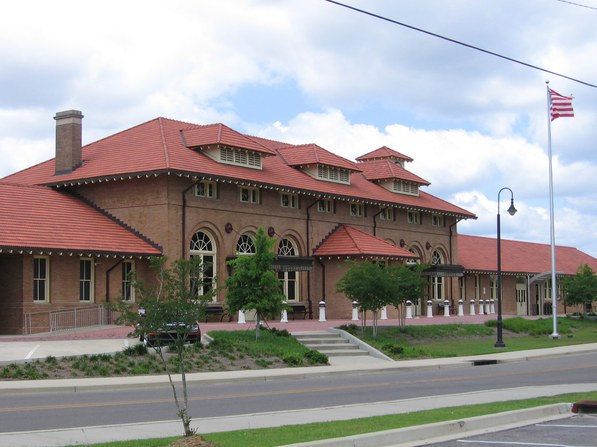When Hattiesburg’s central business district began to decline in the 1970s, civic leaders and residents started to focus on the future and the city’s evolution. Reflecting on their rich history, they opted to reinvest in the rail depot, which served as the nucleus of the city’s major downtown redevelopment.
 Revitalization Efforts
Revitalization Efforts
While the restoration and improvement of the rail depot, erected in 1910, didn’t begin until the early 2000s, the major project was but one piece of a larger economic revitalization effort started in the 1980s to counteract the downtown’s decline. Hattiesburg’s decision to partake in the Main Street program, pioneered by the National Trust for Historic Preservation, helped galvanize momentum among stakeholders toward urban renewal. Small businesses downtown began improving their storefronts, and new sidewalks and parks were installed thanks to funding received from the U.S. Department of Housing and Urban Development’s Community Development Block Grants program.
“The depot is extremely significant; it is the grand piece of the puzzle for what is happening downtown.” – Betsy Rowell, Executive Director, Historic Hattiesburg Downtown Association (HHDA)
Continuing the efforts to spruce up the city’s core, Hattiesburg turned its focus to the historic restoration of two of the town’s great icons, the Saenger Theater and the train depot. The goal was to transform the depot into an intermodal center as well as space that could host special events, and to return one of the state’s few grand movie palaces to its former glory. Leaders viewed the coupling of these restoration projects as key to extending the activity of downtown across the physical and visual barrier of the railroad tracks.
Upon negotiating the purchase of the building and surrounding acreage in 1998, the city pursued the depot project in three phases. Phase I consisted of restoring the clay roof tiles, dormers and skylights. Phase II focused on interior restoration of the ornamental plaster, original flooring, and other historic features while bringing the depot into ADA compliance. Phase III included extending the platform canopy to its original 924-foot length, adding additional parking and landscaping, and realigning the local traffic patterns surrounding the depot to help repurpose it as an intermodal transportation center.
Station as a Catalyst
The depot’s restoration was intended to create “people places” that attract visitors and encourage them to stay and peruse local shops and restaurants. In addition to serving as the terminal for Amtrak and Hub City Transit (the local bus service), parts of the 14,000 square foot depot, such as the Grand Hall, can be rented for private events, generating additional income for the city. Other parts of the building house Hattiesburg’s Geographic Information Systems office and a community room that may be used by residents.
The depot revitalization project provided the necessary push to motivate other property owners to make their own enhancements. The improved transportation access as well as the institution of a new community gathering place encouraged development in the surrounding area and improved visitors’ and residents’ perception of the town. At the depot’s rededication in April 2007, Mayor Johnny Dupree stated “The…depot is the key to understanding the city’s past and is the key component of Hattiesburg’s future.”
Keys to Success
- Engaged many local parties with an interest in community renewal and economic development.
- Utilized the Historic Hattiesburg Downtown Association (HHDA) as a unified voice for project priorities.
- Encouraged local government incentives to spur initial redevelopment activity.
- Maintained continuity across multiple mayoral terms to continue to advance the project.



 Amtrak established the Great American Stations Project in 2006 to educate communities on the benefits of redeveloping train stations, offer tools to community leaders to preserve their stations, and provide the appropriate Amtrak resources.
Amtrak established the Great American Stations Project in 2006 to educate communities on the benefits of redeveloping train stations, offer tools to community leaders to preserve their stations, and provide the appropriate Amtrak resources. For more than 50 years, Amtrak has connected America and modernized train travel. Offering a safe, environmentally efficient way to reach more than 500 destinations across 46 states and parts of Canada, Amtrak provides travelers with an experience that sets a new standard. Book travel, check train status, access your eTicket and more through the
For more than 50 years, Amtrak has connected America and modernized train travel. Offering a safe, environmentally efficient way to reach more than 500 destinations across 46 states and parts of Canada, Amtrak provides travelers with an experience that sets a new standard. Book travel, check train status, access your eTicket and more through the